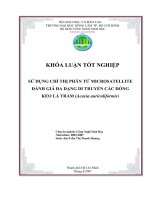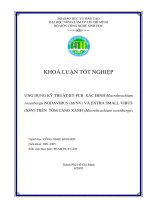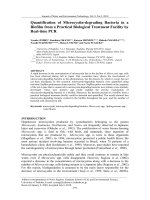Cloning genes by PCR
Bạn đang xem bản rút gọn của tài liệu. Xem và tải ngay bản đầy đủ của tài liệu tại đây (362.21 KB, 24 trang )
Cloning genes by PCR
The cloning of genes is often a crucial step in a scientific project and can
be both difficult and time-consuming. The use of PCR has greatly enhanced
the successes of gene isolation. Cloning of genes by PCR can be divided
into two main areas: (i) genes of known DNA sequence; and (ii) genes of
unknown DNA sequence. Genome sequencing projects (Chapter 11) are
generating an increasing amount of data that makes cloning of genes more
straightforward, however there remain many cases where unknown genes
must be cloned. This Chapter deals with the cloning of both unknown
genes and those that have been previously isolated.
A Cloning genes of known DNA sequence
10.1 Using PCR to clone expressed genes
If a DNA fragment has been isolated containing part of the target gene,
perhaps as a genomic sequence, it can be used to clone a full-length cDNA for
further analysis. Perhaps quantitative RT-PCR (Chapter 8) or real-time RT-PCR
(Chapter 9) has indicated very low levels of expression of the target gene, and
hybridization screening of a cDNA library, using the isolated fragment as a
probe, fails to yield clones. Dealing with a low-abundance transcript can often
be frustrating as conventional cDNA library screening is labor intensive and
success depends on a number of parameters associated with the quality of the
library. First, the quality of the mRNA used to generate the cDNA library is of
great importance since low-abundance transcripts can easily be ‘lost’ during
sample handling. Second, the efficiency of the first- and second-strand cDNA
synthesis should be optimized and monitored by incorporating radiolabeled
nucleotides. Third, the proportion of recombinant clones should be as high
as possible to reduce the number of plaques or bacterial colonies needed to be
screened and to increase the likelihood of cloning low-abundance transcripts.
Even if you manage to generate a good cDNA library it may not be possible
to isolate certain low-abundance cDNA clones. By contrast, it is often possible
to isolate such cDNAs using PCR-based techniques.
Generating cDNA libraries by PCR
Various approaches have been applied to the construction of cDNA libraries
by PCR. Often the rationale for using such an approach is the limited
amount of material available from which mRNA can be produced. Due to
the limitations on materials, such procedures rely on the use of total RNA
preparations as the source of templates for mRNA reverse transcription and
cDNA amplification. An inevitable consequence of this strategy is the
amplification of rRNA sequences that predominate in any total RNA
10
preparation and which form templates for nonspecific or self-priming
reactions leading to a reduction in library quality.
Early methods were based on an oligo-dT primer for first-strand cDNA
synthesis and homopolymer-tailing, often by dCTP, of the 3′-end of these
cDNA strands. PCR with oligo-dG and oligo-dT primers was then
performed. This approach was improved by the inclusion of specific
sequence extensions on the oligo-dG and oligo-dT primers so that rather
than using the homopolymer tracts as priming sites, specific primers
complementary to the primer extensions could be used for increased
specificity. Alternatively, and more efficient than homopolymer tailing,
following standard double-strand cDNA synthesis the molecules can be
blunt-ended by treatment with, for example, Klenow fragment and dNTPs,
and a double-stranded adaptor ligated to provide specific priming sites. Of
course in this case the new priming site would be added to both the 5′- and
3′-ends of the cDNA allowing amplification by a single primer, but this also
results in single strands that have complementary ends that are capable of
annealing. The consequence is a process called suppression, which results
in such self-associated molecules being unavailable as templates for PCR.
This suppression phenomenon has been exploited in some cDNA synthesis
protocols to prevent the nonspecific amplification of rRNA sequences that
are commonly recovered during cDNA library construction from total RNA
preparations (1). In essence the procedure is identical to the generation of
a library by ligation of a double-strand adaptor. The adaptor is added to the
5′- and 3′-ends of each molecule in the library whether derived from mRNA
or rRNA. In the PCR step, however, the adaptor-base primer is added
together with an oligo-dT primer. This will allow amplification of any
molecule, but only the mRNA molecules that have a polyA tail will provide
sites for both the adaptor and oligo-dT primer. Any molecules that are
amplified only by the adaptor primer will have complementary terminal
sequences that will be able to anneal, thus preventing the primer accessing
the site and therefore suppressing the level of representation of such
molecules in the final library. This provides an efficient method for the
selective amplification of mRNA-derived cDNAs.
Solid-phase procedures for library construction have also been developed
that either depend upon the capture of mRNA molecules, by annealing of
the polyA tail to oligo-dT coupled to some form of solid support, or the use
of a biotinylated oligo-dT primer for first-strand cDNA synthesis.
PCR amplification from a cDNA library
A cDNA library is a highly complex mixture of nucleic acids and often, in
the case of a phage library, protein components, and so it is important to
use high stringency conditions for the PCR reaction in order to minimize
nonspecific background amplification. It is convenient to use PCR as a tool
to rapidly screen random clones to determine the quality of a cDNA library.
Essentially random plaques are transferred with a toothpick to a PCR mix
and universal primers flanking the cDNA cloning region are used to amplify
the inserts. A good library should give a high number of clones with inserts
of varying sizes. An example of PCR screening of random clones from a
bacteriophage λ gt10 cDNA library is shown in Figure 10.1.
234 PCR
For the isolation of target genes there are two general approaches to PCR
amplification from a cDNA library:
● from the starting cDNA, which may be one of the increasing sources of
commercially available PCR-ready cDNA samples specifically produced
for this purpose; or
● from the phage library suspension.
During cDNA library construction (ligation, packaging, transfection) to
yield the primary library and its subsequent amplification, the distribution
of clones can be skewed such that the library is not representative of the
starting mRNA population. This can have a particularly adverse effect on
the representation of clones representing low-abundance transcripts. For
this reason it is better, where possible, to start from a cDNA template source,
since this increases the chance of isolating rare transcripts due to the higher
complexity of cDNAs whilst reducing nonspecific amplification due to the
lack of phage DNA. There are no major difficulties associated with direct
PCR amplification from cDNA although the following points should be
considered. First, use a low template concentration such as for genomic
PCR, in the range of 10–50 ng, and second, for rare transcripts use 40–45
amplification cycles. Alternately, use 30 cycles followed by re-amplification
of an aliquot for an additional 25 cycles.
SMART cDNA cloning
Clontech’s SMART™ PCR cDNA synthesis kit facilitates production of high-
quality cDNA from total or polyA RNA as shown in Figure 10.2. Reverse
transcriptase uses a modified oligo-dT primer to generate first-strand cDNA.
Upon reaching the 5′-end of the mRNA the terminal transferase activity of
the reverse transcriptase adds additional nucleotides, normally deoxy-
Cloning genes by PCR 235
12345678 M
Figure 10.1
Screening random λgt10 plaques from a library for the presence of inserts. Several
clones carry inserts of differing size (1, 2, 3, 5, 7, 8) while other clones show no
apparent inserts (4, 6). Photography kindly provided by A. Neelam (University of
Leeds).
cytidine, to the 3′-end of the first-strand cDNA. The SMART II oligo-
nucleotide, containing a 3′ oligo-G sequence, base pairs to these Cs on the
cDNA, and now acts as a ‘new’ template for the reverse transcriptase, which
extends the cDNA to the end of the SMART II oligonucleotide. The
extended full-length single-stranded cDNA, now containing two priming
sites (5′ and 3′), can be used for end-to-end cDNA amplification by PCR.
The majority of cDNAs should represent full-length copies allowing for
efficient amplification of 5′-regions.
It is advisable for all cDNA library production schemes to use primer pairs
that contain engineered restriction sites that will facilitate subsequent
cloning of the PCR-amplified cDNA (Chapter 6).
The second option is to PCR from a phage cDNA library suspension. This
may result in more nonspecific amplification compared with direct PCR
from cDNA. When dealing with phage suspensions it is important to allow
access to the packaged DNA by heating an aliquot of the phage suspension
to 95°C for 5 min or by placing in a microwave oven for 5 min at full power
(700 W). As for direct PCR amplification from library DNA, a low con-
centration of template DNA should be used to minimize nonspecific
236 PCR
First-strand synthesis and dC
tailing by reverse transcriptase
Template switching and
extension by reverse
transcriptase
PCR amplification
cDNA
mRNA
mRNA
First-strand cDNA
mRNA
First-strand cDNA
oligo-dT
+
SMART II
SMART II
SMART II
oligo-dT
oligo-dT
AAAAAAAAAA
AAAAAAAAAA
pp
pG
M
e
5
'
pp
pG
M
e
5'
CCC
GGG
5'
5'
CCC
GGG
p
pp
G
M
e
5'
AAAAAAAAAA
GGG
5'
Figure 10.2
The principle of SMART™ PCR cDNA synthesis kit for generating full–length cDNA
molecules.
amplification events. When a cDNA library is generated it is usual to check
the integrity of the library by analyzing random clones for the presence of
inserts of varying sizes that correspond to different initial transcripts, and
such a screen is shown in Figure 10.1. The identification of positive clones
is usually achieved by filter transfer of plaques from a plate, followed by
fixing the released DNA to the membrane, then hybridization with a labeled
probe. In initial library screens it is difficult to isolate single plaques and so
the screening must be repeated. However, PCR screening can be used to try
to isolate individual clones by amplification from dilutions of a library
(Figure 10.3). When the lowest dilution that still gives a positive result is
identified this corresponds to the number of plaques that must be screened
to isolate a single positive. If this number is small (10–50), then it is possible
to pick individual plaques to screen. If the number remains large (>50) then
a further hybridization experiment is probably more efficient.
10.2 Expressed sequence tags (EST) as cloning tools
DNA sequence databases provide a wealth of EST sequences and these can
be used as very efficient tools for gene cloning by PCR. ESTs are DNA
sequences of the 5′- or 3′-ends of cDNA clones often randomly picked from
a cDNA library, or as a subpopulation of clones isolated from a develop-
mental library, perhaps by differential screening. The sequence information
is limited to usually about 500 nucleotides, the amount generated from a
single sequencing reaction. Thus for any given cDNA clone there can be
two ESTs, one corresponding to 5′- and one to 3′-sequence, but in many
cases the region between these extremes is unknown. Nonetheless, the
limited sequence information is sufficient to search databases to identify
homology to known genes, or genomic regions. Most importantly, if you
search a database with a sequence of interest and identify an EST, then this
means that a cDNA clone of your target gene is available. In most cases
Cloning genes by PCR 237
30 000
15 000
7500
3750
1875
940
470
235
120
60
60
M
(B)
75 000
50 000
37 500
18 750
12 500
6250
3125
1560
M
(A)
Figure 10.3
Screening dilutions of an enriched λgt10 cDNA library for the presence of a target
clone. The number of plaque–forming units (p.f.u.) present in the PCR are
indicated above each lane; M is molecular size markers. (A) The initial enrichment
shows detection of a clone in 6 250 p.f.u. (B) Subsequent enrichment reveals the
presence of a clone in the highest dilution sample that contains 30 p.f.u.
Photographs kindly provided by A. Neelam (University of Leeds).
ESTs can be ordered, for a small handling fee, from various stock centers in
the form of a plasmid containing the cDNA. There are also a growing
number of commercial biotechnology companies that offer a variety of EST
clones, but these can be expensive.
EST sequence data provide a rapid mechanism for obtaining cDNA
sequence data from your gene without the need to screen cDNA libraries.
In some cases you may wish to use the EST sequence data for rapid cloning
of the target gene by RT-PCR, cDNA library PCR or genomic PCR. This is
achieved by designing an oligonucleotide primer complementary to part of
the EST sequence for use in conjunction with a 5′- or 3′-gene-specific
primer, an adaptor primer or a universal vector-specific primer. The latter
is used either for amplification from an existing cDNA library or where the
cDNA has been ligated to a vector as a convenient mechanism for adding
a universal primer site. If both 5′- and 3′-ESTs are available then two primers
could be designed to amplify a selected part of the cDNA clone, such as the
protein-coding region.
10.3 Rapid amplification of cDNA ends (RACE)
RACE is a procedure for amplification of cDNA regions corresponding to
the 5′- or 3′-end of the mRNA (2) and it has been used successfully to isolate
rare transcripts. The gene-specific primer may be derived from sequence
data from a partial cDNA, genomic exon or peptide.
3¢-RACE
In 3′-RACE the polyA tail of mRNA molecules is exploited as a priming site
for PCR amplification. mRNAs are converted into cDNA using reverse
transcriptase and an oligo-dT primer as described in Protocol 8.1. The
generated cDNA can then be directly PCR amplified using a gene-specific
primer and a primer that anneals to the polyA region.
5¢-RACE
The same principle as above applies but there is of course no polyA tail
(Figure 10.4). First-strand cDNA synthesis extends from an antisense primer,
which anneals to a known region at the 5′-end of the mRNA. However, there
is no known priming site available for the subsequent PCR amplification.
The trick is to add a known sequence to the 3′-end of the first-strand cDNA
molecule as described in Protocol 10.1. Terminal transferase, a template-
independent polymerase, will catalyse the addition of a homopolymeric tail,
such as poly-dC, to the 3′-end of each cDNA molecule. PCR amplification
can now be performed using a nested internal antisense primer together with
an oligo-dG primer. This will allow the specific amplification of unknown
5′-ends of the mRNA molecule. Alternatively, as discussed for cDNA library
construction (Section 10.1), double-strand cDNA synthesis can be followed
by blunt ending and adaptor ligation. This provides a specific primer site
that in combination with the nested gene-specific primer will lead to ampli-
fication of the 5′-end of the cDNA. A common problem with these
approaches is that the cDNAs are not always full-length.
238 PCR
A significant advance in the production of full-length 5′-end RACE
products is the use of the CapSwitch primer (Clontech). As described in
Chapter 8 this allows the addition of a specific primer sequence to the
5′-end of each cDNA by virtue of the homopolymer C-tail added by the
reverse transcriptase. This new primer site can be used together with a gene-
specific primer for efficient 5′-RACE.
5¢- and 3¢-RACE
An efficient procedure for cloning both 5′- and 3′-ends of cDNAs or full-
length molecules uses adaptor ligation and allows the isolation of both
5′-and 3′-cDNA ends from the same cDNA preparation (3). The adaptor
utilizes a vectorette feature for selective amplification of a desired end
(Section 10.6) as well as suppression PCR to reduce background ampli-
fication (Section 10.1.1).
The technical details of the RACE reaction itself will not be described here
since a variety of commercial kits for RACE are available and have optimized
protocols and reagents that work very efficiently. These are relatively
expensive but more time and money may be spent in optimizing the
procedure using a series of independent reagents.
Cloning genes by PCR 239
mRNA
Reverse transcription
to generate cDNA
cDNA
Tailing cDNA using dCTP
and terminal transferase
Anneal primers
GSP2
Primary PCR
GSP3
Secondary PCR
Clone and sequence
5’ 3’
AAAAAAAAA
CCCC
GSP1
CCCC
CCCC
cDNA
cDNA
cDNA
Figure 10.4
Outline of the 5′-RACE technique. Total RNA or mRNA is subjected to reverse
transcription using a gene-specific primer (GSP1) priming in the 5′ direction. The
resulting cDNA is tailed followed by amplification using a tail-specific primer and a
nested gene-specific primer (GSP2). Following this a nested amplification reaction
is performed using a tail-specific primer and a nested gene-specific primer (GSP3).
An improvement to standard RACE techniques has recently been
reported (4). PEETA (Primer extension, Electrophoresis, Elution, Tailing,
Amplification) involves resolving the extension product after reverse
transcriptase followed by elution from a gel, then dC-tailing and PCR ampli-
fication. It is claimed to be more efficient than the standard RACE
procedure and aids in the mapping and cloning of alternatively spliced
genes.
Clearly during the design of 5′- and 3′-RACE experiments the primer
positions can be located so that the final products have a region of overlap.
It is then a simple process to join the two parts of the cDNA by SOEing
(Chapter 7). This involves mixing the fragments and performing at least
one cycle of PCR, although more cycles can be performed and flanking
primers used in the RACE amplifications can be included to amplify the
full-length product.
B Isolation of unknown DNA sequences
It is often of interest to isolate and clone unknown DNA fragments that lie
adjacent to already cloned regions of DNA. One obvious example is the
isolation of downstream or upstream regulatory regions, including
promoters. A further application that is increasingly common is the
isolation of flanking regions next to transposon insertions as part of gene
knockout strategies. Various approaches to the PCR cloning of unknown
DNA sequences will be outlined.
10.4 Inverse polymerase chain reaction (IPCR)
PCR allows the specific amplification of genomic DNA regions that lie
between two primer sites facing one another. What if the region of interest
lies either 5′ or 3′ in relation to the primer sites? The answer is inverse PCR
(IPCR) (5). The principle of IPCR is shown in Figure 10.5 and involves the
digestion of genomic DNA with appropriate restriction endonucleases,
intramolecular ligation to circularize the DNA fragments and PCR ampli-
fication. PCR uses primer pairs that originally pointed away from each other
but which after ligation will prime towards one another around the circular
DNA.
The principle and the protocol for IPCR (Protocol 10.2) are the same what-
ever the application and so as an example the use of IPCR for the isolation
of flanking DNA sequences that lie next to a transposon insertion will be
described.
Isolation of genomic DNA, digestion and ligation
The success of IPCR is largely dependent on the efficiency of intramolecular
ligation of the target DNA fragments within a complex mixture of non-
target fragments. A prerequisite is the use of high-quality genomic DNA
that should ideally be prepared by using an available commercial kit. The
integrity of the DNA should be checked by agarose gel electrophoresis and
240 PCR
should not show any smearing or small molecular size species, including
RNA.
A 500 ng aliquot of genomic DNA should be digested with a restriction
endonuclease enzyme that digests within the known DNA region, in this case
within the transposon, and which will also cut within the unknown DNA
region (Figure 10.5). It is advisable to set up several different restriction
enzyme digests, if possible, since the efficiency of the subsequent PCR
amplification decreases rapidly for fragment sizes above 2 kbp in size. Follow-
ing heating to 70°C to inactivate the restriction enzyme, an aliquot can be
retained for gel analysis (see below) and the remainder of the restriction digest
reaction should be diluted five-fold in ligation mixture (ligation buffer, H
2
O,
ligase) and incubated for 6–12 hours at room temperature.
To check the efficiency of restriction digestion and ligation, Southern blot
analysis can be performed, in this case using part of the transposon as a
probe. An aliquot of the genomic digest should be analyzed along with the
ligation reaction. If both the restriction digest and ligation were successful,
Cloning genes by PCR 241
Region of known DNA sequence
XbaI XbaI
Primer 1
Primer 2
Primer 3
Primer 4
XbaI digestion
and ligation
First PCR and second
nested PCR amplification
Primer site 1 Primer site 3
Unknown DNA sequence
XbaI
Primer 3
Primer 1
Primer 2
XbaI
Primer 4
Figure 10.5
Schematic diagram showing the principle of IPCR from genomic DNA. After
restriction endonuclease digestion and religation the first round PCR is performed,
in this case using primers 2 and 4. Following this the second-round nested PCR is
carried out using primers 1 and 3 which should give rise to one specific
amplification product.









